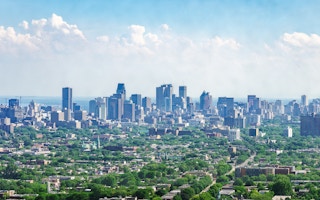Animals have a way of beating the odds by using what’s been given. If it’s not the one-inch cathedral termite that architects a five-metre home on the Australian outback, it’s the beaver who rearranges the river’s flow with its bucked teeth. All around us, nature is giving and taking, budding and dying, to keep the same centuries-old symbiotic song playing.
Once upon a time, humans were no exception to this rule. Arctic Eskimos were given the option of ice or more ice, and so igloos were born as dome-shaped structures that miraculously had you peeling off some layers when blizzard storms blew. Populations in the tropics adapted to the heat and humidity by building lightweight elevated timber structures with wide openings and breezeways to allow cool night air to permeate their houses and remove the heat build-up from the day. Generally, we were pretty good at staying in step with the environment for a very long time.
But somewhere along the way our intellectual superpowers meant we didn’t have to work with only what mother nature had dished up for our disposal. We could actually change it. And the greater our ability to re-engineer our habitats to our advantage, the more detrimental it tended to be to our habitats. One project at a time, we have been rearranging our built spaces to satisfy our immediate demands, and the casualties in our wake have just been crammed under the carpet.
Let’s face it—if you’ve got money, you can beat your own ecological odds. When it’s hot, turn up the air conditioning. If there’s drought, suck the water out of the ground or squeeze the salt out of seawater, and voila! No rain dance needed! The paradox, of course, is that by doing these things we only make it hotter and drier for the rest of the world, with the most vulnerable populations bearing the heaviest blow. Make no mistake: there always is a price to pay; it’s just a question of who pays it.
In a world of no constraints, can we be trusted not to swing the pendulum hard towards the easy solution? But can we actually be trusted to take the time to find the middle, where we uphold both the immediate and long-term picture? If we’re going to find this optimum balance, we’re going to have to think precinct over project and planet over precinct. We’re going to have to step back and look at the overall ecosystem we are building. Our job is not merely to meet the brief, but to transform communities into a better picture than the one we inherited.
Building our hives
For centuries, we have been upgrading our own hives. We live, eat and sleep inside the security and comfort of our homes. We learn inside the four walls of school, college or university. Our careers are often crafted over time inside a custom-designed building. We gather food in built biospheres called malls. To get around, we carve out roads that criss-cross canyons or cut straight through mountains. When we want to exercise, we join air-conditioned gyms or visit sporting venues. Slowly over time, we are re-engineering the landscape to serve our habits and lifestyles .
But each individual design has wide-scale impact that ripples through society. When a double lane road is thrown down to get traffic flowing, it also severs the natural flow of that community. When a shopping centre comes to town, suddenly the pleasant chats around the neighbourhood corner store dissipate, and the social glue that forms the community fabric begins to break down. Spaces slapped by mega malls and high-density roads are no longer intuitive and integrative, but disjointed ecosystems that cut through the sweet intangibles that make community what it is.
Going beyond the brief
Project by project, we are reinventing our world. We meet the brief (we may even wow the client and one-up it), but if we treat that project as an isolated design, then, to some degree, we’ve actually failed. With climate change and urban influx breathing down our backs, we can’t afford to think in boxes anymore.
We have to align our work to a bigger story. We have to think of every project as part of the tapestry that interweaves the social fabric of the community in which it is placed. We need to put the “soul” back into project briefs, where human interaction can flourish and community is nurtured. When was the last time a project brief had a requirement to increase the amount of serendipitous moments of human interaction?
Technology, public works, architecture and policy all have a part to play in the push towards sustainable urbanism. The goal being “sustainable and livable”, the idea is to live simpler and far more connected as people and built environments to the natural world around us. And thanks to this rising conscientiousness, cities are starting to rethink the way they build and plan, so that green high-performance buildings and infrastructure are connected by walkways, cycling paths, bus routes and other transit systems with a low carbon footprint.
But the reality is, these pockets of progressiveness are still rare. Even if fantastic innovations are remodelling the neighbourhood, rarely do they ‘talk’ to the core components of urban planning and together build an overall vibe ̶ a sense of place that pulsates with purpose. Usually they hit the technical and ideological targets of the building, and that’s about it.
“
With climate change and urban influx breathing down our backs…We have to think of every project as part of the tapestry that interweaves the social fabric of the community in which it is placed.
Rebecca Solnit put it this way: “In great cities, spaces, as well as places, are designed and built: walking, witnessing, being in public, are as much part of the design and purpose as is being inside to eat, sleep, make shoes or love or music. The word citizen has to do with cities, and the ideal city is organised around citizenship — around participation in public life.” The role of the engineer is not only to create an exceptional space but to foster a place that has personality and flavour.
Advising on the future
If we wear the capes in this superhero saga, shouldn’t we do more than just serve up what the client ordered? Surely, we should be using our powers to show the way? With insight into the project’s long-term impact, who better to advise and negotiate for the end user, owner, and community than the engineer?
Understanding the clockwork of a city is understanding what makes it tick and come to life. And understanding this requires some serious head locking between urbanists, scientists, economists, ecologists, architects and engineers. Through this kind of tight collaboration, we can pick up the city’s peculiar heartbeat and make sure that each of our investments together make the city become a better version of itself.
Engineering is both prophetic and proactive . We pull down conceptions into reality and modify our physical world with the unimaginable. The privilege and responsibility of it should both thrill and terrify us. That’s why it’s never enough to cut, copy, paste, repeat our knowledge and experience. After all, as Abraham Maslow suggests, if the only tool you have is a hammer, you treat everything as if it were a nail.
Pumping out the same solutions for different problems won’t get us there. The onus is on us to stop, study and speak through our designs to the flavour and flow of that particular city pocket. It’s definitely a big responsibility, but it’s an even bigger privilege.
Martin Smith is Technical Director & Technical Leader - Mechanical & National Green Building Design Leader in RSA Optimising projects at Aurecon. This post was republished from Aurecon’s Just Imagine blog with permission.











